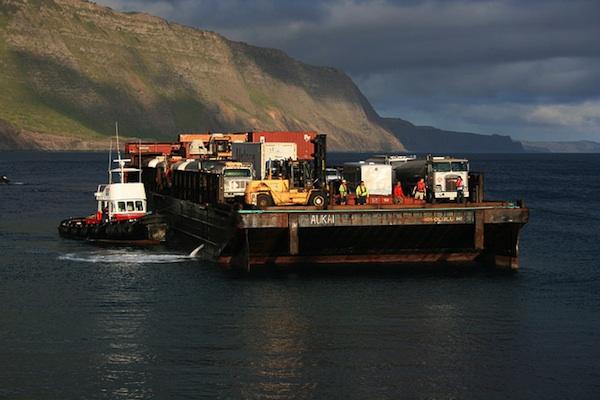
August 2 marked "Barge Day" At Kalaupapa National Historical Park/NPS
Every so often, something pops up that sounds so fascinating, it simply must be investigated. That's what happened the other day when I made my daily visit to the NPS Morning Report and found an article that set my curiosity ablaze. I don't remember ever having heard of Kalaupapa and I know I'll never be able to visit the place in person, but thanks to modern electronic communications and the Internet, I was able to visit virtually. Since half the fun of discovering something new is sharing it with others, I'll use Traveler to do that with you . . . . the following was compiled by Ranger Timothy Jordan.
Annual Supply Shipment Welcomed On Barge Day
Saturday, August 2nd, was one of the most highly anticipated days of 2014 for Kalaupapa National Historical Park and the small and isolated settlement of Kalaupapa, Hawaii.
On one summer day each year, a barge from Honolulu delivers all of the settlement's supplies for the upcoming year. Carefully arranged on the barge deck are new vehicles, fuel trucks, and shipping containers loaded with pallets of food stuffs, large appliances, furniture, building supplies and more. It is on this day that the sleepy settlement of only ninety people bustles with people and machines, unloading the supplies as quickly and safely as possible.
Kalaupapa's natural isolation has always made receiving supplies extremely difficult. The twelve-square-mile peninsula on which the park is located juts out of the north shore of the island of Molokai, with rough ocean waters on three sides and 2,000-foot-high sheer cliffs on the fourth.
Historically, residents who purchased large or heavy items that could not be brought in by mule or small plane waited until the annual barge day to receive them. A resident-patient of Kalaupapa once described Barge Day as being like Christmas ' 'The number one day. The big day that everybody waits for'¦'
This year, Barge Day began around 7 a.m. on Saturday, August 2nd. The barge appeared on the horizon heading towards Kalaupapa with the aid of a tug boat. Community members gathered to watch, while Hawaii Department of Health and NPS employees in hard hats and orange vests stood ready to assist with unloading. By 8 a.m., the barge had tied up to the pier and unloading had begun. First to roll off the barge were three fuel tankers to replenish the settlement's supply of gasoline and diesel fuel. Also unloaded were twelve new vehicles, two new forklifts, a backhoe, and dump truck.
Then a flurry of forklifts and heavy lifting equipment began unloading dozens of shipping crates and pallets containing supplies ranging from food to lime mortar and sand for gravestone restoration work. Dozens of workers from the state federal governments and the Young Brothers' barge team worked through the morning unloading numerous shipping containers and pallets.
After the barge was unloaded of all its cargo supplies, it was loaded with shipping crates containing a year's worth of the settlement's aluminum and plastic recyclables scrap metal, defunct vehicles, old appliances, and hazardous materials. Prior to the barge's arrival, state and federal employees had staged these materials nearby for easy removal.
By the early afternoon, the barge embarked on its journey back to Honolulu, while Kalaupapa residents and workers unpacked all of the supplies for the coming year.
Kaluapapa, which honors the memories and experiences of the people forcibly sent here beginning in the 1860s because they were afflicted with leprosy, today is a highly restricted area as it still serves as a community for about eight or nine surviving patients of the old colony. While they've been cured of the diseasase, they still bear its disfiguring marks.
Visitors must have a permit to enter and may do so only when escorted by tour guides. No visitors under the age of 16 are permitted. Boats are not allowed within a quarter-mile of shore. There is no camping, no lodging, and no food facilities within the park. The Hawai'i Department of Health regulates access to the park. There's a limit of 100 visitors a day to the park, but typically there are only 20-40 a day.
A quick phone call to the park informed me that about 45 staff work there, and most live at the site.
If you want to learn more there are literally hundreds of websites with information about the park and its history. Turn your Google search on and have fun!



Comments
And there is nothing 'unique' about our only isolated Hansen's Disease colony, where one of the people supporting the patients was granted sainthood for his efforts.
This discussion is why selfish self-centered people are not allowed to make artibtrary decisions based on their ignorance.
Let me see here - Kalaupapa, Brown vs Bd of Education, Tuskeegee Airmen, Manzanar... yup. For some reason it sure looks obvious that someone arguing against each and every one of those at the same time just might be mired a little bit in some white privilege.
Oh, so now we are going to throw out the race card?
How about I add Herbert Hoover National Historic Site, Jimmy Carter National Historic Site, Ronald Reagan Boyhood Home National Historic site, John F Kennedy National Historic Site and virtually every other "privledged white President" whose home is a National Historic site.
I didn't "throw out the race card". I noticed what you had said. "Throw out the race card" is right wing doublespeak for "damn, I got busted".
You go ahead disassembling the NPS in your mind. Thank the gods and goddesses it isn't within your power.
Really?
No. This discussion was celebrating the annual barge arriving at Kalaupapa. Then it got derailed.
Derailed, indeed. Any further comments need to be in a more civil tone, and pertinent to the subject at hand, or we'll just shut this one down.